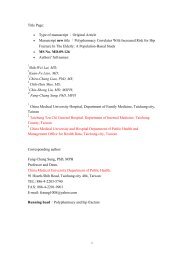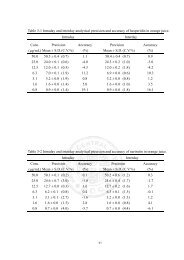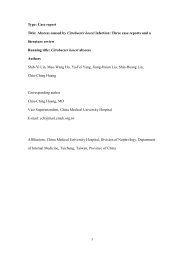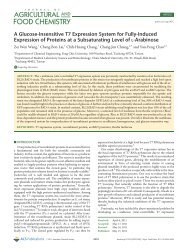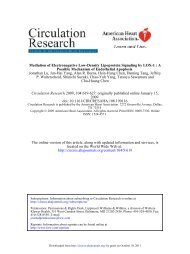Culinary Narratology in Everyday Life: Foodways and Identity ...
Culinary Narratology in Everyday Life: Foodways and Identity ...
Culinary Narratology in Everyday Life: Foodways and Identity ...
Create successful ePaper yourself
Turn your PDF publications into a flip-book with our unique Google optimized e-Paper software.
<strong>Cul<strong>in</strong>ary</strong> <strong>Narratology</strong> 12<br />
immigrant <strong>in</strong> the US. She is overwhelmed, <strong>and</strong> feels “so far from home, unmonitored <strong>and</strong><br />
unobserved by those she loved . . . [<strong>and</strong>] terrified to raise a child <strong>in</strong> a country where she is<br />
related to no one, where she knows so little, where life seems so tentative <strong>and</strong> spare” (5-6).<br />
Ashima, the pregnant subject, is alienated <strong>and</strong> fragmented by a ruptured life that is<br />
“haphazard, only half true” (24-25).<br />
Ashima’s perceptions of her physical boundaries have shifted, <strong>and</strong> she has the sensation<br />
that her body is simultaneously herself <strong>and</strong> non-self, a feel<strong>in</strong>g somewhat like that of be<strong>in</strong>g an<br />
alienated immigrant. Consequently, Ashima’s body is caught <strong>in</strong> a state of double<br />
estrangement, <strong>and</strong> she beg<strong>in</strong>s to realize that be<strong>in</strong>g an immigrant is a sort of lifelong<br />
pregnancy:<br />
a perpetual wait, a constant burden, a cont<strong>in</strong>uous feel<strong>in</strong>g out of sorts. It is an<br />
ongo<strong>in</strong>g responsibility, a parenthesis <strong>in</strong> what had once been ord<strong>in</strong>ary life, only to<br />
discover that that previous life has banished, replaced by someth<strong>in</strong>g more<br />
complicated <strong>and</strong> dem<strong>and</strong><strong>in</strong>g. Like pregnancy, be<strong>in</strong>g a foreigner, Ashima believes, is<br />
someth<strong>in</strong>g that elicits the same curiosity from strangers, the same comb<strong>in</strong>ation of<br />
pity <strong>and</strong> respect. (49-50)<br />
With another life, which symbolizes an Other, exist<strong>in</strong>g <strong>and</strong> grow<strong>in</strong>g <strong>in</strong>side the body, the<br />
process of pregnancy biologically “alienates” women’s bodily perceptions, <strong>and</strong> thus entails<br />
the most extreme suspension of bodily externality of the <strong>in</strong>side (Young 50). This sense of<br />
bodily alienation is analogous to the circumstance of be<strong>in</strong>g an immigrant <strong>in</strong> diaspora, for the<br />
sense of bodily <strong>in</strong>tegrity <strong>in</strong> both situations is dismantled <strong>and</strong> <strong>in</strong> a state of flux. In pregnancy,<br />
Ashima’s “automatic body habits become dislodged” (Young 50), <strong>and</strong> the cont<strong>in</strong>uity between<br />
her customary body <strong>and</strong> her pregnant body is disjo<strong>in</strong>ted <strong>and</strong> broken. Analogously, as an<br />
immigrant woman, she is also deprived of the firm sense of synthesis of her body <strong>in</strong> a<br />
diasporic context, unable to perceive the border of where her body ends <strong>and</strong> where the<br />
exterior world beg<strong>in</strong>s. Ashima compares her experience of pregnancy to the ambivalent



